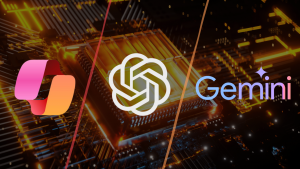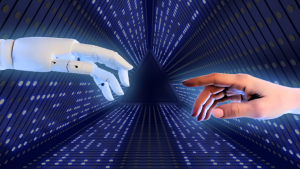Generative AI technologies, such as OpenAI’s GPT-4, have significantly accelerated the creation of diverse content, from text and images to video and audio. But despite seemingly creating content out of thin air, the actual creativity of generative AI models can be seen as lacking upon deeper analysis. These models can easily deceive regular users by producing ‘creative results’ at first glance, but their working mechanisms reveal the limitations of their creativity.
How Generative AI Works
Generative AI has been around for decades, initially employed in tasks such as pattern recognition and statistical modeling. Recent advancements in deep learning and neural networks have dramatically expanded its capabilities.
Earlier AI models relied on rule-based programming, which required explicit coding for every scenario and structured data formats like tables or spreadsheets.
Generative AI models are designed to create content that mirrors the characteristics of the data on which they have been trained. These models use neural networks to analyze data, identify patterns, and generate similar content, utilizing unsupervised and semi-supervised learning methods to process vast amounts of unlabeled data.
For training, generative models like GPT-4 are exposed to extensive datasets, including hundreds of gigabytes of text, images, code, and other digital content sourced from books, articles, websites, and publicly available information. These models aim to emulate human creativity by generating outputs such as text, images, videos, and code.
For instance, GPT-4, with its 1.76 trillion parameters, is capable of producing highly detailed and contextually relevant content.
Modern Generative AI and its Capabilities
Today’s generative AI models demonstrate greater flexibility. Trained on substantial real-world data, they can generate original content based on various prompts. This progress has led to advanced models like GPT-4 and DALL-E, which create human-like text, realistic images, music, and even code. These developments signify a significant leap in AI’s potential to replicate human creativity and problem-solving.
Generative AI models leverage neural networks to discern patterns and structures within existing data, enabling the creation of new content. Neural networks consist of algorithms that mimic the human brain’s function, using layers of nodes (or neurons) to transform and filter input data to make predictions or generate new outputs.
Neural Networks and Learning Methods
Modern AI models utilize unstructured data—such as text, images, and audio from the internet—which allows them to learn from complex examples that more closely resemble real-life situations.
Techniques like transformers, introduced in 2017, have been pivotal in enhancing AI’s ability to understand and generate language by focusing on word relationships in a broader context. This advancement has significantly improved the quality of AI-generated content.
Utilizing learning methods such as unsupervised learning, where the model identifies patterns in unlabeled data without explicit instructions (e.g., clustering images into categories), and semi-supervised learning, which combines a small amount of labeled data with a large volume of unlabeled data (e.g., using a few annotated medical images to train a model to detect diseases), these models can efficiently manage large datasets.
These models are considered foundational because they support complex AI systems capable of performing diverse tasks, such as generating human-like text, creating realistic images, and simulating scientific research outcomes, thereby demonstrating a wide range of capabilities across various domains.
Limitations of ‘AI Creativity’
The process starts with feeding a large language model (LLM) with extensive datasets, enabling it to generate text and media at unprecedented speeds. Yet, despite its advanced capabilities, AI creativity encounters significant constraints.
A study in Science Advances from July has highlighted that while AI can assist in generating content, its creative contributions come with significant limitations. Researchers examined how GPT-4 impacted human creativity by comparing outputs from groups using AI for idea generation versus those relying solely on their creativity.
The results revealed that while AI boosted the creativity of less inventive individuals, it had minimal effect on more inherently creative people. This dichotomy suggests that AI’s impact on creativity heavily depends on the user’s initial creative capacity.
The study measured novelty and usefulness – key metrics in assessing creativity. While AI improved the outputs of less creative individuals, it also led to a convergence of ideas, making AI-assisted stories more uniform compared to human-generated ones. This has pointed out that AI, despite its capabilities, tends to narrow rather than broaden creative diversity.
Further research published in Nature in February compared AI and human performance in divergent thinking tasks. GPT-4 excelled in generating original responses and scored higher in semantic distance, indicating greater novelty. However, this does not necessarily translate to superior overall creativity. The study revealed that AI’s ability to generate novel ideas is constrained by its difficulty in evaluating their real-world usefulness and appropriateness, crucial aspects of genuine creativity.
The Impact on Human Creativity and Innovation
AI’s limitations extend beyond performance metrics. Repeated findings indicate that AI-generated content often lacks the depth and context of human creativity. As noted by Tuhin Chakrabarty, a computer science researcher at Columbia University, AI-generated stories frequently exhibit artificial traits like lengthy, exposition-heavy sentences and reliance on stereotypes, which undermine their creativity and originality.
The homogenization of AI-generated content is another concern. Since AI models are trained on vast datasets, the content they produce mirrors the patterns and biases within those datasets. This often results in a narrower range of creative output, as seen in the Science Advances study. With many AI-assisted writers creating similar content, there is a risk of reducing innovation in creative fields.
Moreover, excessive reliance on AI may impact human creative processes. While AI tools can automate repetitive tasks and enhance certain creative aspects, overuse might stifle genuine human ingenuity.
Hence, excessive dependence on AI could undermine creative efforts, as recent findings have warned. This is why AI should complement, not replace, human creativity, which is shaped by unique experiences and insights beyond the reach of AI
Concerning AI limits, we can take another research published in Nature, which shows that while GPT-4 performs well on certain creative metrics, its capabilities are confined to the scope of its training data, lacking the ability to generate truly novel concepts without human input.
The current functionality of generative AI—creating new outputs from existing data—cannot be considered fundamentally creative. Manipulating existing data to produce new outputs does not imply limitless creativity; instead, its role in innovation should be evaluated in light of its limitations in generating innovative ideas. This will not change until the eventual rise of Artificial General Intelligence (AGI), which we will discuss in another post.
- Can LLMs generate better research ideas than humans? A critical analysis of creativity and feasibility - September 25, 2024
- Artificial Super Intelligence: Transcending Imagination - September 15, 2024
- Artificial General Intelligence: Start of a New Era - September 8, 2024



